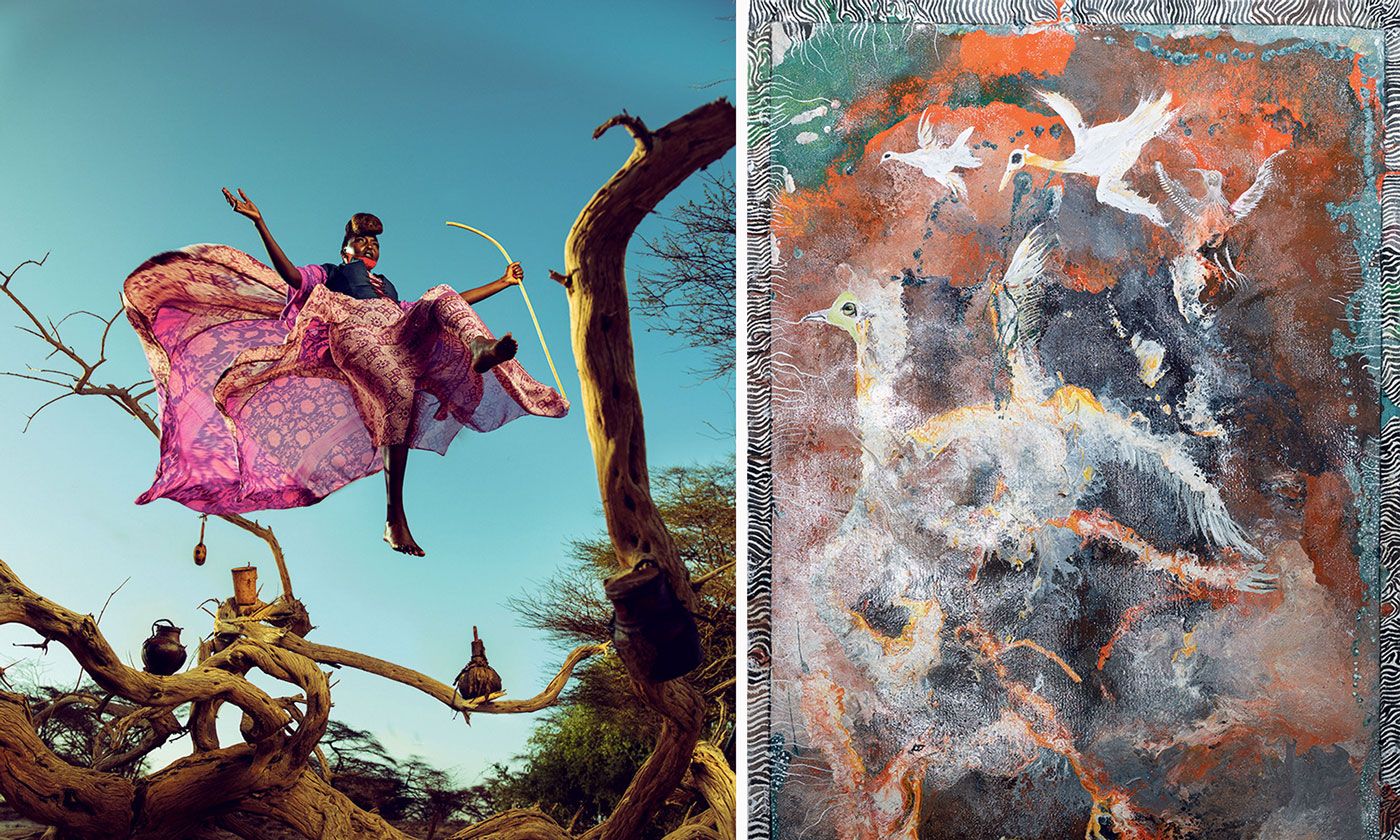A concern for ecology: an image from the photo essay Floating, Flying by the photographer Migwa Nthigah and fellow members of Turkana Artists Xchange, and World Fires, oil on canvas, by Solomon Misigo, of Pamoja collective Floating, Flying: Elizabeth Korikel, Margy Modo, Chebet Mutai and Migwa Nthigah for Turkana Artists Xchange. Misigo: Courtesy of the artist; photographed by Jed Kamuyu
When the work of the late Peter Beard—the New York- and Kenya-based photographer of the big fauna of sub-Saharan Africa and of Francis Bacon, Jackie Kennedy Onassis and 1970s Manhattan cool—comes up for auction, the most prized lots are those large-format prints whose broad, vividly detailed borders were painted, over more than four decades, by local artists at the Hog Ranch Art Department, part of a compound that Beard owned outside Nairobi.
These painted borders, in watercolour and tempera, and the collage, script and painting applied to the prints by both the photographer and the Hog Ranch artists—some of it far from marginal and covering close to half the surface area of the original photographs—make Beard’s work instantly recognisable. The big auction houses today acknowledge the work of individual Hog Ranch artists, such as E. Mwangi Kuria, Nathaniel Kiboi (or Kivoi) and Solomon Misigo, in catalogue entries for Beard works that can fetch upwards of $500,000 each.
Nicholas Njenga, of Pamoja collective, Hungry Vultures, acrylic on paper Courtesy of the artist; photographed by Jed Kamuyu
E. Mwangi Kuria, otherwise Elizaphanson Mwangi Gibson and now in his 78th year, his near contemporary Kiboi, and Misigo (born 1976), are three of eight former Hog Ranch artists who today make up the Pamoja art collective, and whose recent solo works take centre stage and promise to give New Yorkers a fresh look at the contemporary art scene in Kenya in the show Kenyan Collectives at Affirmation Arts.
Nicholas Njenga (top), of Pamoja collective, working on Majestic Love (above), oil on paper Courtesy of the artist; photographs by Jed Kamuyu
The exhibition brings together about 25 paintings by members of Pamoja, largely addressing the interaction between Kenya’s wildlife and its rural and urban populations, and around 15 photographs from fashion- and ecology-based narrative series made by members of Turkana Artists Xchange, a group of 14 creatives based in Nairobi and in the Turkana region in the far north of Kenya who work in visual art, music, fashion and design. The two collectives are also showing collaborative works in which Turkana photographs are framed with distinctive borders painted by Pamoja artists.
The exhibition—the penultimate show at Affirmation Arts before the artist-supporting gallery owned by the artist and philanthropist William T. Hillman moves this summer from its purpose-built base (which the city has acquired under eminent domain) in Hudson Yards to a new site in the Meatpacking District—came together when the gallery was introduced to two Kenyan documentary film-makers, Lucy Chodota and Jackie Lebo. Chodota is making a film about Pamoja and their post-Hog Ranch work. Lebo, a Nairobi-based documentarian and founder of Content House, a collective of film-makers, photographers, artists and writers, was making a film in Turkana spurred by the threat to the area’s ecology posed by the discovery of oil in 2012, when she met the group of artists who inspired the collective photography project.
Picha Marangi and Elizabeth Korikel in The Flyest Wedding, a fictional art project for the Turkana Xchange collective Project director: Jackie Lebo; project lead: Chelagat Tum; photographer: Migwa Nthigah
The other Pamoja members showing in Kenyan Collectives are Mwangi’s sons Gibson Kuria Mwangi and Macharia Mwangi; Gabriel Macharia, a contemporary of Kiboi and the elder Mwangi; and two more artists of the younger generation, Marimbe Parsimei and Nicholas Njenga. For Chotoda, the exhibition will go a long way towards restoring the dignity of the Pamoja artists “and addressing the social injustice experienced by African contributors to internationally acclaimed artworks”. It gives this group of Kenyan artists, “a chance to promote their work on a global platform, [and to] gain the recognition and at least some compensation they deserve”, she says.
The Pamoja collective, in portraits by Jed Kamuyu, from top row to bottom: Elizaphanson Mwangi Gibson (left) and Gabriel Macharia; Nathaniel Kiboi (left) and Nicholas Njenga; Gibson Kuria Mwangi (left) and Marimbe Parsimei; Macharia Mwangi (left) and Solomon Misigo Jed Kamuyu
Dennis Santella and Michael Allen, of Affirmation Arts, who are curating the show, are excited at bringing the work of both collectives to the United States for the first time, and are providing the gallery’s service in kind so as to maximise the income going to the selling artists. Allen is looking forward to having his aesthetic prejudices challenged by the show. Some of the Pamoja works, “are really amazing. Very abstract but bringing very detailed animal figures that emerge out of the abstraction,” Santella says. Chodota hopes that the exhibition will acquaint an international audience “with modern Africa and its vibrant art scene”.
Mourine Apuu in a shot from Oil + Milk, a project of Turkana Artist Xchange which addresses the discovery of oil in Turkana by personifying the properties, black and white, of two liquids which have great significance in the region Artist & model: Mourine Apuu; photographer: Migwa Nthigah
Both collectives are concerned with the threat to Kenya’s ecology, confronted by global warming, pollution and the race for the country’s natural resources. Commenting on his acrylic on paper Hungry Vultures, Njenga refers to the effect of drought where “even the vultures” have nothing to feed on. For his oil on canvas World Fires, Misigo writes of “birds/creatures dying hopelessly”. For one of the Turkana collective projects, the artists Elizabeth Korikel, Margy Modo and Chebet Mutai and the photographer Migwa Nthigah created a fictional photo essay, Floating Flying, shot in Eliye Springs, Lake Turkana, the largest desert lake in the world, which, they say, “is in danger of drying up if the damming of the Omo River continues unchecked”.
• Kenyan Collectives, until 26 May, Affirmation Arts

